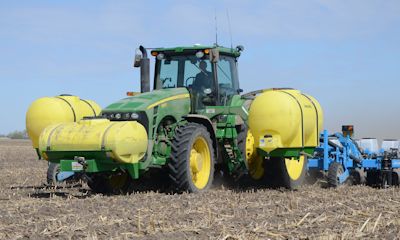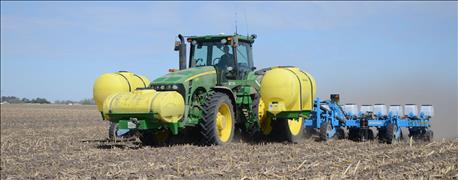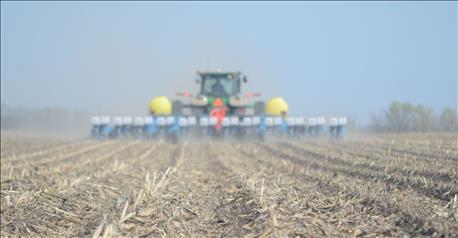
Kevin Medow has been seeing double for ten years now. Back in 2005, he purchased his first Monosem twin row planter, and is now on his second. But he didn't stop there. Medow, who farms in Butler and Seward counties, plants with as many as five different row spacings and four different pieces of planting equipment, depending on the year, location, and crop rotation.
This includes a 36-inch twin row Monosem planter, a 36-inch Monosem planter, a 30-inch John Deere planter with an offset hitch to adjust to 15-inch rows, and a 10-inch John Deere no-till drill. But those planters aren't just for show – each row spacing and machine has its own special purpose.

PLANTING TWINS: Kevin Medow plants corn with his Monosem twin row planter in April. Like many who plant with twins, Medow saw it as an opportunity to go to narrower rows without changing his entire equipment lineup. It also allowed him to maintain a wide ridge on his ridge till acres.
"It gives us a lot of flexibility," Medow says. "As our seed corn acres fluctuate, and they do from year to year depending on the demand, it gives us the ability to roll with those changes and not upset our systems. We have ridge till and we have no-till fields, and they aren't really interchangeable. So if we do have a year where we can't plant seed corn, we're going with commercial corn."
"That started us off, and kind of grew into what we are now," he adds. "You grow and learn as you go and look for opportunity that fits your operation economically."
Crop rotation flexibility
Like many who plant in twin rows, Medow was looking for a way to go narrower without having to change his entire equipment lineup. He was also looking for a way to maintain a wide, flat ridge on his ridge-till acres, and that meant he had to stick with 36-inch rows. Twin row was the perfect solution.

CROP ROTATION FLEXIBILITY: Kevin Medow plants with different row spacings depending on the year, location, and crop rotation, including 36-inch twin rows (pictured here). When he started planting twin rows, he was looking for a way to go narrower without having to change his entire equipment lineup. He also wanted toy to maintain a wide, flat ridge on his ridge-till acres, and that meant he had to stick with 36-inch rows.
All of his commercial corn acres are in continuous corn, and that's where his twin row planter sees the most use. On these acres, Medow rotates between twin and single rows to give the root balls time to decay.
The acres that aren't in continuous corn are in seed corn in 30-inch rows, rotated with soybeans. When he first bought a twin-row planter, he was planting soybeans in twin rows too, but with the offset hitch on his 30-inch planter, he can plant soybeans in 15's. With the no-till drill, he can plant soybeans in 10's, and can have two machines planting soybeans at the same time.
~~~PAGE_BREAK_HERE~~~
The drill also helps adapt in years when his seed corn acres are reduced. During these years, when he has to rotate soybeans with commercial corn, the drill allows him to plant soybeans at an angle to the old corn rows. "If we're bumped out of the seed rotation for some reason, we go into commercial corn with the twin row and the following year use the drill for soybeans," Medow says.

RIGHT HYBRID FOR THE JOB: Twin row is part of a larger system that allows Medow to maintain uniformity at higher populations. It also takes the right hybrid to thrive in a high-population environment where it's crucial to maintain uniformity.
Meanwhile, raising seed corn allows him to establish cover crops earlier, and the no-till drill ensures a good stand of cover crops like cereal rye. "When you destroy the male row, it's pretty easy to go in and seed brassicas. You get a good stand because you're still irrigating. Then after harvesting the seed corn, we seed rye," Medow explains.
Agronomic advantages
But there are also some agronomic benefits to planting corn and soybeans on narrower rows, Medow says, although some research suggests the yield increase can be negligible.
One of the often-touted benefits of narrower rows is earlier canopy closure, improving sunlight capture, which should translate into higher yields and provide greater competition against weeds. "I'm looking for sunlight hitting the ground. If you've got a good stand then there isn't any sunlight hitting the ground. It's all hitting the canopy," Medow says.
Twin row is part of a larger system that allows Medow to maintain uniformity at higher populations. With twin rows, especially at 36 inches, it's easier to push populations without overcrowding plants – Medow typically plants 31,000 to 32,000 seeds per acre on singles to 35,000 to 36,000 on twins. There's also more uniform seed singulation and distribution with planter meters rotating at about half speed, and more uniform nutrient uptake, since Medow bands triammonium polyphosphate sulfate (TAPPS) on 18-inch centers, or 4.5 inches from the row on twins, compared to 9 inches on singles.
But it also takes the right hybrid to thrive in this high-population environment where it's crucial to maintain uniformity, Medow adds. "I think some hybrids perform a little better in twin row. Fixed ear hybrids can take the stress of higher populations," he says. "If everything else is adequate, they should be able to perform to a higher yield at a higher population."
Read more about how Medow puts different row spacings to work in the June Nebraska Farmer.
About the Author(s)
You May Also Like






